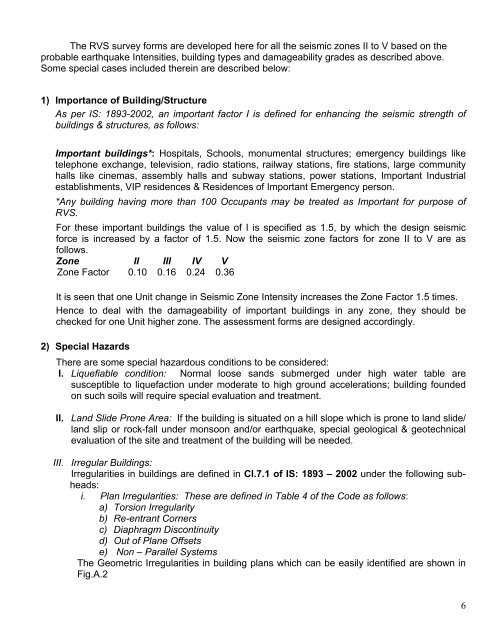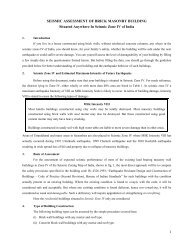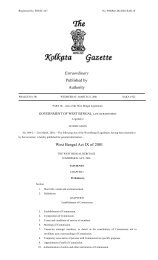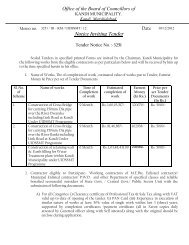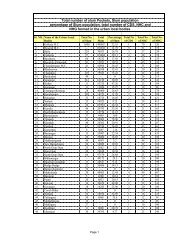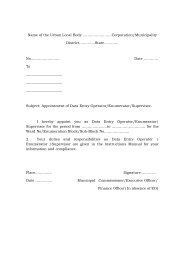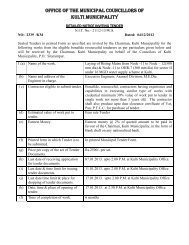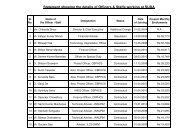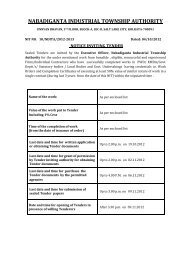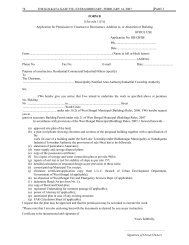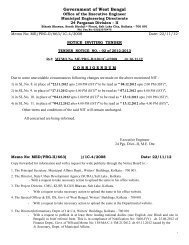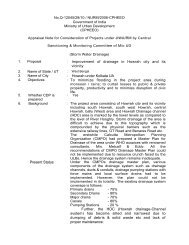Rapid visual screening of masonry buildings - NIDM
Rapid visual screening of masonry buildings - NIDM
Rapid visual screening of masonry buildings - NIDM
Create successful ePaper yourself
Turn your PDF publications into a flip-book with our unique Google optimized e-Paper software.
The RVS survey forms are developed here for all the seismic zones II to V based on theprobable earthquake Intensities, building types and damageability grades as described above.Some special cases included therein are described below:1) Importance <strong>of</strong> Building/StructureAs per IS: 1893-2002, an important factor I is defined for enhancing the seismic strength <strong>of</strong><strong>buildings</strong> & structures, as follows:Important <strong>buildings</strong>*: Hospitals, Schools, monumental structures; emergency <strong>buildings</strong> liketelephone exchange, television, radio stations, railway stations, fire stations, large communityhalls like cinemas, assembly halls and subway stations, power stations, Important Industrialestablishments, VIP residences & Residences <strong>of</strong> Important Emergency person.*Any building having more than 100 Occupants may be treated as Important for purpose <strong>of</strong>RVS.For these important <strong>buildings</strong> the value <strong>of</strong> I is specified as 1.5, by which the design seismicforce is increased by a factor <strong>of</strong> 1.5. Now the seismic zone factors for zone II to V are asfollows.Zone II III IV VZone Factor 0.10 0.16 0.24 0.36It is seen that one Unit change in Seismic Zone Intensity increases the Zone Factor 1.5 times.Hence to deal with the damageability <strong>of</strong> important <strong>buildings</strong> in any zone, they should bechecked for one Unit higher zone. The assessment forms are designed accordingly.2) Special HazardsThere are some special hazardous conditions to be considered:I. Liquefiable condition: Normal loose sands submerged under high water table aresusceptible to liquefaction under moderate to high ground accelerations; building foundedon such soils will require special evaluation and treatment.II. Land Slide Prone Area: If the building is situated on a hill slope which is prone to land slide/land slip or rock-fall under monsoon and/or earthquake, special geological & geotechnicalevaluation <strong>of</strong> the site and treatment <strong>of</strong> the building will be needed.III. Irregular Buildings:Irregularities in <strong>buildings</strong> are defined in Cl.7.1 <strong>of</strong> IS: 1893 – 2002 under the following subheads:i. Plan Irregularities: These are defined in Table 4 <strong>of</strong> the Code as follows:a) Torsion Irregularityb) Re-entrant Cornersc) Diaphragm Discontinuityd) Out <strong>of</strong> Plane Offsetse) Non – Parallel SystemsThe Geometric Irregularities in building plans which can be easily identified are shown inFig.A.26


